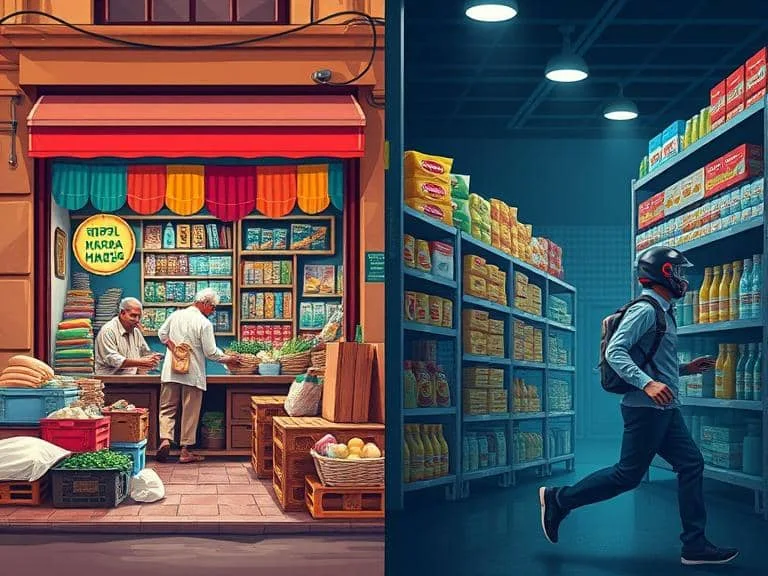Over the past few years, something subtle yet powerful has reshaped the way we shop. A tap on your phone, a few swipes—and within minutes, your groceries, snacks, or medicines are at your doorstep. Apps like Blinkit, Swiggy Instamart, Zepto, and Zomato have become household names, promising one thing above all: unmatched convenience.
But behind this modern-day miracle lies a ripple effect that stretches far beyond your living room. While it saves you time, it may be silently dismantling the very fabric of your local economy.
The Rise and Rise of Quick Commerce
Quick commerce, or Q-commerce, refers to ultra-fast delivery services that bring essentials to your door within 10 to 30 minutes. It’s the retail revolution everyone’s talking about—and for good reason.
In India alone, the Q-commerce sector reached a staggering ₹19,000 crore in gross merchandise value in 2023. Industry analysts predict this figure could balloon to $5.5 billion by 2025, and even hit $10 billion by 2029, according to reports from Redseer and Statista.
So, what’s driving this growth? Urban lifestyles are evolving. Consumers now crave speed, app-based ease, and lucrative discounts. On the surface, it’s progress. But dig a little deeper, and you’ll uncover a more complicated narrative—one where convenience comes at a cost.
Kirana Stores: The Quiet Casualties
India’s 12 million+ kirana stores have long been the unsung heroes of the nation’s retail economy. These family-run businesses offer not just daily essentials but a deep sense of community, personal relationships, and neighborhood trust.
However, the rapid adoption of Q-commerce is putting immense pressure on these small shops. According to a study by Datum Intelligence, nearly 46% of Q-commerce users now purchase less from local kiranas. Among them, 82% have moved at least a quarter of their regular shopping online.
The result? A 25–30% drop in footfall and sales, especially in Tier-1 cities and metropolitan areas. Once-bustling local markets are turning quiet. The friendly banter, neighborhood credit, and warm greetings are being replaced by cold push notifications.
The Technology and Pricing Divide
Why can’t kirana stores fight back? The answer lies in the systems that power Q-commerce.
Platforms like Zepto or Blinkit buy directly from major FMCG brands in bulk, cutting out intermediaries. This enables them to offer steep discounts—something your neighborhood shop simply can’t afford. They’re still dependent on traditional distributors and wholesalers.
On top of that, Q-commerce platforms are powered by advanced tech: AI-based demand forecasting, real-time inventory tracking, and logistics automation. Kirana stores rarely have access to such tools, creating an uneven playing field where innovation becomes exclusion.
The Dark Side of Design: Digital Manipulation
The concern doesn’t stop at pricing and logistics. Many Q-commerce apps are now being scrutinized for dark patterns—deceptive design tactics that trick users into actions they didn’t intend.
In 2024, the Indian government issued notices to 11 major apps, including Zepto, Ola, and Uber, for such manipulative interface practices. Shockingly, 97% of global e-commerce platforms use at least one form of dark pattern.
Common tactics include:
- Bait and Switch: You think you're canceling a service, but you’re actually subscribing.
- Sneak into Basket: Products get added to your cart without consent.
- Forced Continuity: Free trials automatically become paid subscriptions.
- Fake Urgency: Countdown timers push you into panic buying with artificial deadlines.
These practices exploit human psychology—not to serve users better, but to drive up sales.
From Ownership to Dependency
The most profound shift caused by quick commerce is the centralization of retail power. Where once ten kirana shops thrived—each supporting a family—today, a single dark store handles the area’s needs. And those shopkeepers? Some have now become gig workers for the very platforms that replaced their livelihood.
This isn’t just economic disruption—it’s a role reversal. Independent business owners are turning into delivery agents. Local control is shrinking, while the reins tighten in the hands of a few powerful platforms.
Reimagining Progress: What Can Be Done?
Quick commerce isn’t inherently bad. It plays a vital role during emergencies, supports people with limited mobility, and suits the pace of modern life. But growth shouldn’t come at the expense of community and small business resilience.
Here’s what must change:
- Regulate dark store setups, particularly in residential and vulnerable zones.
- Integrate local sellers into the Q-commerce supply chain to ensure inclusive growth.
- Mandate transparency on pricing, delivery conditions, and user data policies.
- Ban dark patterns and ensure genuine consent in digital interactions.
Progress should be inclusive. Innovation must serve the many, not just the powerful few.
Final Thoughts: A Smarter, Kinder Retail Future
Quick commerce reflects the incredible possibilities of tech-led retail. But if left unchecked, it risks converting our vibrant community markets into faceless, app-driven monopolies.
Let’s not forget what makes shopping special—trust, relationships, and local bonds. As we move forward, the goal shouldn't be just speed, but sustainability. The future of retail should be fast, fair, and human.
“Have you stopped shopping from your local kirana store? Share your experience in the comments or tag us with your thoughts on instagram #storyantra”

















0 Comments